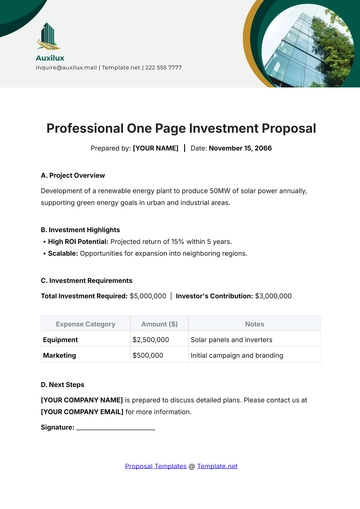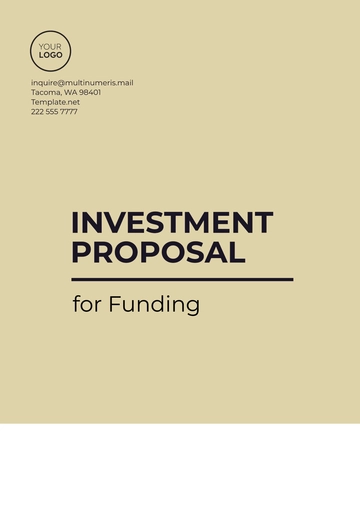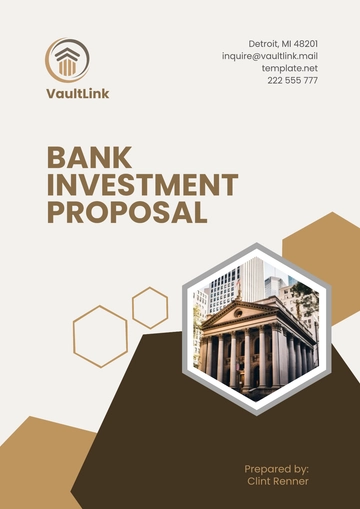Free Bank Investment Proposal

I. Executive Summary
A. Purpose of the Proposal
This investment proposal seeks to establish a strategic partnership between [Your Company Name] and potential investors to capitalize on growth opportunities in the banking sector. By leveraging innovation, technology, and strategic positioning, the proposed investment aims to deliver substantial financial returns while ensuring sustainable growth for all stakeholders. The partnership will facilitate the expansion of digital banking services and innovative financial products across new markets, aligning with industry trends that demand efficiency, convenience, and accessibility. We believe this partnership will not only provide financial success but also set a new standard for the banking experience in the digital age.
B. Objectives of the Investment
The key objectives of this investment proposal are:
Enhancing Digital Banking Infrastructure: The aim is to build a cutting-edge, AI-driven digital banking platform that simplifies financial management for consumers, enabling greater access to banking services. The platform will utilize the latest advancements in data analytics and AI to provide tailored financial solutions, improving customer experience and engagement.
Expanding Market Reach: The investment will enable [Your Company Name] to enter high-potential emerging markets that have low banking penetration but a growing demand for digital financial services. These regions are expected to contribute significantly to revenue growth over the next decade.
Delivering Strong Financial Returns: The investment seeks to achieve a projected ROI of [20%] annually starting from the year [2051], with consistent revenue growth driven by the adoption of innovative financial products and services. By leveraging economies of scale and efficient operations, the proposed investment will maximize profitability.
Sustainability Alignment: The partnership will also align with global sustainability goals by incorporating green banking practices, such as eco-friendly lending products and investments in renewable energy projects. This will position [Your Company Name] as a leader in responsible banking, attracting environmentally conscious customers.
II. Industry Overview
A. Banking Industry in 2050
The global banking industry in 2050 is projected to be valued at approximately $[20 trillion], with digital banking services accounting for over [65%] of all transactions. This shift is driven by increasing customer demand for more accessible, secure, and efficient banking solutions. The industry has evolved from traditional brick-and-mortar banks to highly sophisticated, tech-driven institutions, offering everything from AI-powered financial advisors to blockchain-enabled payment systems.
The banking sector is expected to continue growing as consumers increasingly prefer mobile banking apps and online platforms for their daily transactions. The ability to conduct secure, real-time transactions has made digital banking not only more convenient but also more accessible to the global population. In 2050, nearly [85%] of all banking transactions will be carried out via smartphones, contributing to a faster pace of financial inclusion in underserved regions.
B. Current Market Trends and Opportunities
Emerging Markets Growth: Rapid urbanization in developing countries presents a significant opportunity for expansion in the banking sector. With the rise of the middle class, an increasing number of consumers are seeking reliable banking products and services. It is expected that the banking market in emerging markets will grow at an annual rate of [15%] over the next decade. This growth is supported by the adoption of mobile and internet banking, making banking services more accessible to previously unbanked populations.
Demand for Innovative Products: There is a growing interest in banking products that go beyond traditional savings and loans. Consumers are now seeking personalized services like AI-driven financial advice, insurance products tailored to individual needs, and integrated investment solutions. With the global trend toward financial literacy and empowerment, banking customers are becoming more proactive in managing their finances, seeking products that offer real-time insights and financial planning tools.
Blockchain and Cybersecurity: Blockchain technology is revolutionizing the banking sector by providing secure, transparent, and efficient methods of managing financial transactions. Over [50%] of global banks are now integrating blockchain into their operations, primarily for cross-border payments and fraud prevention. Additionally, with the rise of digital transactions, the need for strong cybersecurity measures is more critical than ever. Banks must invest in state-of-the-art security systems to protect sensitive customer data and prevent fraud.
III. Investment Details
A. Scope of the Investment
This proposal outlines an investment of $[125 million] to enhance [Your Company Name]’s position in the global banking market. The funds will be allocated across several key areas to maximize the impact of the investment:
Digital Infrastructure Development: A significant portion of the investment will be directed toward the development of an AI-powered digital banking platform. This platform will allow customers to access banking services from anywhere, enabling [Your Company Name] to offer personalized, real-time financial solutions that meet the needs of modern consumers.
Market Expansion: A key aspect of the investment is the expansion into new markets with low banking penetration. Over the next [5 years], we plan to establish a presence in [10] high-potential countries, each with a growing population and an increasing demand for digital financial services. By focusing on regions with high mobile phone usage and internet access, we expect to reach millions of new customers who currently lack access to traditional banking services
Product Diversification: The investment will support the development of a range of new products tailored to the needs of underserved markets. These will include microloans, eco-friendly savings accounts, and insurance products that leverage AI to provide more accurate risk assessments. By diversifying the product offering, [Your Company Name] will not only attract a wider customer base but also increase customer retention and satisfaction.
B. Funding Requirement Breakdown
Category | Funding Required ($) | Percentage |
|---|---|---|
Digital Infrastructure | 50 million | 40% |
Market Expansion | 30 million | 24% |
Product Development | 20 million | 16% |
Marketing and Branding | 15 million | 12% |
Operational Contingency Funds | 10 million | 8% |
Total | 125 million | 100% |
IV. Strategic Benefits
A. Financial Returns
The investment in [Your Company Name] is expected to generate substantial financial returns, with a projected ROI of [20%] annually, beginning in [2051]. As the market penetration increases, the returns are expected to scale up due to the increased volume of transactions and the diversification of products. The projected return will be supported by the growth of digital banking services, microloans, and green financing initiatives that will attract a loyal customer base and improve financial sustainability.
B. Market Penetration and Expansion
Through this investment, [Your Company Name] will establish a strong presence in untapped markets that represent a significant portion of the global population. These regions include parts of Africa, Southeast Asia, and Latin America, where traditional banking services are limited. By reaching an estimated [5 million] new customers by the year [2053], the company will expand its market share by [15%], contributing to long-term growth and brand recognition.
C. Innovation and Technological Advancements
Adopting AI, machine learning, and blockchain technologies will enable [Your Company Name] to stay ahead of the competition. AI will allow for personalized financial advice, reducing the need for human intervention and increasing the efficiency of operations. Blockchain will ensure secure, transparent transactions, particularly in cross-border payments and remittances, which are expected to grow at a rate of [20%] annually. By staying at the forefront of technological advancements, [Your Company Name] will solidify its reputation as a leader in digital banking.
V. Risk Assessment and Mitigation Strategies
A. Potential Risks
Market Volatility:
The financial markets are subject to rapid fluctuations in economic conditions. Unforeseen events, such as a financial crisis, significant shifts in commodity prices, or political unrest, can destabilize markets and introduce uncertainty.
The volatility of currencies, particularly in emerging markets, could affect the valuation of assets and liabilities. This could potentially impact both domestic and international banking operations.
Furthermore, any sudden changes in the macroeconomic landscape could lead to reduced consumer spending or increased loan defaults, adversely affecting profitability.
Cybersecurity Threats:
As the banking industry increasingly integrates digital tools and platforms, cyber risks have become one of the most significant threats to operational stability.
Data breaches, whether through phishing attacks, ransomware, or insider threats, can lead to both financial and reputational damage. These breaches often result in customer distrust, which can be difficult to rebuild.
Moreover, as new technologies such as quantum computing become more prevalent, traditional encryption techniques may become obsolete. This necessitates a proactive approach to adopting the latest security protocols.
Regulatory bodies around the world are also tightening cybersecurity standards, which means that non-compliance or delayed responses to new security requirements could result in significant legal and financial penalties.
Regulatory Challenges:
The regulatory landscape for financial institutions is constantly evolving. From Anti-Money Laundering (AML) to Know Your Customer (KYC) guidelines, [Your Company Name] must ensure full compliance with diverse laws across different jurisdictions.
In recent years, governments have introduced increasingly stringent regulations to address financial instability, consumer protection, and environmental sustainability. These regulations could require large investments in compliance and monitoring systems.
Additionally, the introduction of new taxes or levies on the banking sector, such as a digital transaction tax or carbon tax, could further reduce profitability.
Banks also face potential risk if they are unable to meet evolving climate-related financial disclosure requirements, which could affect investment inflows and cost of capital.
Technological Obsolescence:
The pace of technological change in the banking sector is rapid. In recent years, we’ve seen the rise of fintech disruptors who have introduced agile, customer-centric platforms, such as neobanks and cryptocurrency-based financial solutions.
As consumers become more accustomed to seamless, real-time experiences across industries, there is an increasing expectation that banks will deliver similar service. Failure to meet these expectations could lead to customer attrition.
Additionally, legacy banking infrastructure may hinder the integration of cutting-edge technologies such as artificial intelligence (AI), machine learning, and blockchain. Failure to invest in technological upgrades may cause inefficiencies and missed opportunities.
Over-reliance on third-party software or infrastructure could create vendor lock-in situations, where the costs of switching or upgrading become prohibitive.
B. Mitigation Strategies
Market Volatility:
Diversification of Investments: To reduce risk, [Your Company Name] plans to diversify its portfolio across different asset classes, sectors, and geographical markets. By investing in both developed and emerging markets, the firm can cushion itself against localized economic shocks.
Hedging Strategies: Engage in currency and interest rate hedging strategies to protect the value of assets and liabilities from market volatility. These hedging instruments will allow the company to better manage unpredictable shifts in the market.
Flexible Financial Models: Implement financial models that allow for flexibility in response to changing market conditions. For example, incorporating scenario planning into budgeting processes can prepare the company for various market conditions, from economic booms to recessions.
Cybersecurity Threats:
Continuous Security Monitoring: Implement advanced AI-driven cybersecurity systems capable of detecting and responding to threats in real-time. These systems will be constantly updated to handle the latest threats and vulnerabilities.
Employee Training: Conduct regular training programs for employees on identifying cybersecurity risks such as phishing and social engineering attacks. Employee awareness is crucial as human error remains one of the largest contributors to data breaches.
Collaboration with Cybersecurity Firms: Collaborate with leading cybersecurity firms to conduct regular penetration testing and vulnerability assessments to identify weaknesses before they can be exploited.
Regulatory Challenges:
Dedicated Compliance Team: Establish a dedicated team of regulatory experts who can track and respond to changes in banking regulations across all markets. This team will work closely with legal and risk management departments to ensure full compliance at all times.
Regulatory Technology (RegTech): Invest in RegTech solutions that can automate and streamline compliance processes, reducing the cost and complexity of meeting regulatory standards. These technologies will help ensure adherence to KYC/AML laws, taxation, and environmental reporting requirements.
Active Policy Engagement: Actively participate in industry forums, regulatory consultations, and lobbying efforts to influence policy changes. By contributing to discussions, [Your Company Name] can anticipate regulatory trends and adapt more quickly.
Technological Obsolescence:
Investment in Emerging Technologies: Allocate a portion of the company’s R&D budget to exploring and implementing emerging technologies such as blockchain, quantum computing, and next-gen AI. By staying ahead of technological trends, [Your Company Name] can ensure it remains at the cutting edge of banking innovation.
Partnerships with Fintech Firms: Forge strategic partnerships with fintech startups to gain early access to innovative solutions and provide customers with next-generation services. Collaborations can also help to accelerate digital transformation by leveraging external expertise.
Cloud-Based Infrastructure: Transition to a more scalable, flexible cloud-based infrastructure that allows for quick integration of new tools and technology. This will also minimize the risk of vendor lock-in and reduce the operational cost of upgrading systems.
VI. Financial Projections
A. Revenue Growth Projections
The projected growth rate of revenue is driven primarily by the increasing customer base, coupled with the introduction of high-margin digital services. The revenue per customer is expected to gradually decrease as the customer base grows, though total revenue will continue its upward trajectory.
B. Profit Margins and ROI Analysis
Profit Margins:
As the business scales, the cost per acquisition and customer service costs are expected to decrease. Automation and technological advancements will improve efficiency, driving an increase in profit margins from [18%] in [2050] to [30%] by [2054].
Additional high-margin offerings, such as premium wealth management services and automated advisory, are anticipated to contribute significantly to profitability.
ROI Analysis:
A steady ROI of [25%] per year from year [2052] to [2054] is expected as initial investments in infrastructure and market entry start to pay off. By year [2054], [Your Company Name] anticipates a total ROI of [120%], reflecting strong growth in both revenue and customer base.
Cash Flow Projection:
Positive cash flow is projected to occur by [2052], with a cash surplus of $[50 million] expected by year [2054]. The surplus will be used to reinvest in expanding operations and funding new product developments.
VII. Implementation Plan
A. Expanded Timeline
Milestone | Target Year | Details |
|---|---|---|
Investment Secured | 2050 | Securing $125 million in investment, allowing the company to initiate its full market entry strategy. |
Digital Platform Development | 2051 | Completing the development of the AI-powered banking platform that will facilitate a seamless, secure, and scalable user experience. |
Entry into First 5 Markets | 2052 | Expanding into 5 key emerging markets with strong growth potential, focusing on digital financial services. |
Full Expansion Across 10 Regions | 2053 | Achieving market leadership in key regions such as Asia, Africa, and Latin America. |
Green Financing Product Launch | 2053 | Introducing a suite of environmentally sustainable financial products, including green bonds and carbon-neutral loans. |
Initial ROI Realized | 2054 | Achieving positive ROI and profitability from the growing customer base and product suite. |
B. Key Performance Indicators (KPIs)
Customer Base: Aim to acquire [5 million] new customers by [2054] by focusing on underserved regions and offering innovative services.
Transaction Volume: Target a [50%] year-on-year increase in digital transaction volume, capitalizing on mobile banking and AI-based services.
Revenue from New Products: Generate [30%] of revenue from new products, particularly in the area of green financing and wealth management.
VIII. Conclusion and Call to Action
This proposal represents a significant opportunity for [Your Company Name] to revolutionize the banking industry in the coming decades. Through strategic investments in technology, expansion into emerging markets, and the introduction of high-margin financial products, we are positioning ourselves to lead the industry in the years ahead.
We invite you to partner with us in this transformative journey. Your investment will enable us to:
Achieve sustainable, long-term profitability by tapping into new markets and innovative products.
Become a leader in the global banking sector, driving both technological and environmental innovation.
Deliver exceptional value to our customers, employees, and investors alike.
Please reach out to [Your Name] at [Your Email] to schedule a meeting or visit [Your Company Website] for more information on how you can be part of this exciting future.
Let’s build the future of banking together!
- 100% Customizable, free editor
- Access 1 Million+ Templates, photo’s & graphics
- Download or share as a template
- Click and replace photos, graphics, text, backgrounds
- Resize, crop, AI write & more
- Access advanced editor
Secure investments with the Bank Investment Proposal Template from Template.net. This editable and customizable template helps you craft a professional proposal to attract investors. Customize it with ease using the AI Editor Tool to fit your financial goals. Create your investment proposal now!
You may also like
- Business Proposal
- Research Proposal
- Proposal Request
- Project Proposal
- Grant Proposal
- Photography Proposal
- Job Proposal
- Budget Proposal
- Marketing Proposal
- Branding Proposal
- Advertising Proposal
- Sales Proposal
- Startup Proposal
- Event Proposal
- Creative Proposal
- Restaurant Proposal
- Blank Proposal
- One Page Proposal
- Proposal Report
- IT Proposal
- Non Profit Proposal
- Training Proposal
- Construction Proposal
- School Proposal
- Cleaning Proposal
- Contract Proposal
- HR Proposal
- Travel Agency Proposal
- Small Business Proposal
- Investment Proposal
- Bid Proposal
- Retail Business Proposal
- Sponsorship Proposal
- Academic Proposal
- Partnership Proposal
- Work Proposal
- Agency Proposal
- University Proposal
- Accounting Proposal
- Real Estate Proposal
- Hotel Proposal
- Product Proposal
- Advertising Agency Proposal
- Development Proposal
- Loan Proposal
- Website Proposal
- Nursing Home Proposal
- Financial Proposal
- Salon Proposal
- Freelancer Proposal
- Funding Proposal
- Work from Home Proposal
- Company Proposal
- Consulting Proposal
- Educational Proposal
- Construction Bid Proposal
- Interior Design Proposal
- New Product Proposal
- Sports Proposal
- Corporate Proposal
- Food Proposal
- Property Proposal
- Maintenance Proposal
- Purchase Proposal
- Rental Proposal
- Recruitment Proposal
- Social Media Proposal
- Travel Proposal
- Trip Proposal
- Software Proposal
- Conference Proposal
- Graphic Design Proposal
- Law Firm Proposal
- Medical Proposal
- Music Proposal
- Pricing Proposal
- SEO Proposal
- Strategy Proposal
- Technical Proposal
- Coaching Proposal
- Ecommerce Proposal
- Fundraising Proposal
- Landscaping Proposal
- Charity Proposal
- Contractor Proposal
- Exhibition Proposal
- Art Proposal
- Mobile Proposal
- Equipment Proposal
- Student Proposal
- Engineering Proposal
- Business Proposal





























